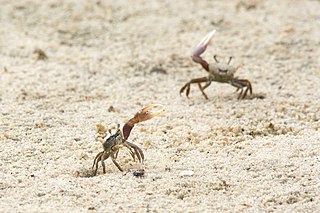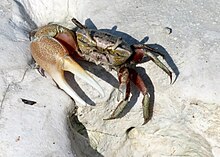
The fiddler crab or calling crab may be any of more than one hundred species of semiterrestrial marine crabs in the family Ocypodidae, well known for their sexually dimorphic claws; the males' major claw is much larger than the minor claw, while the females' claws are both the same size. A smaller number of ghost crab and mangrove crab species are also found in the family Ocypodidae. This entire group is composed of small crabs, the largest being slightly over two inches (5 cm) across. Fiddler crabs are found along sea beaches and brackish intertidal mud flats, lagoons, swamps, and various other types of brackish or salt-water wetlands.

The Ocypodidae are a family of semiterrestrial crabs that includes the ghost crabs and fiddler crabs. They are found on tropical and temperate shorelines around the world.

Leptuca pugilator, the sand fiddler crab, Atlantic sand fiddler crab, or Calico fiddler, is a species of fiddler crab that is found from Massachusetts to the Gulf of Mexico. It lives in burrows in coastal and estuarine mud-flats, and can be extremely abundant. It can be differentiated from the morphologically similar Minuca pugnax and Minuca minax by the smoothness of the inside of its claws. One claw is larger than the other, and can be much larger than the crab's body, at up to 41 mm (1.6 in) long.

Leptuca crenulata, the Mexican fiddler crab, is a species of American broad-front fiddler crab in the family Ocypodidae.

Leptuca thayeri, known generally as the Atlantic mangrove fiddler crab or mangrove fiddler, is a species of true crab in the family Ocypodidae. It is distributed all across the Western Atlantic.

Leptuca spinicarpa, commonly known as the spiny-wristed fiddler crab or the spined fiddler crab, is a species of fiddler crab native to coastal habitats along the Gulf of Mexico from northwestern Florida to Mexico.

Leptuca panacea, commonly known as the Gulf sand fiddler crab or the Panacea sand fiddler, is a species of fiddler crab native to coastal habitats along the Gulf of Mexico from northwestern Florida to Mexico.
Leptuca speciosa, commonly known as the brilliant fiddler crab or the longfinger fiddler crab, is a species of fiddler crab native to the southern United States, Mexico, and the Caribbean.
Leptuca subcylindrica, commonly known as the Laguna Madre fiddler crab or the puffed fiddler crab, is a sparsely-studied species of fiddler crab native to southern Texas and northeastern Mexico in the Gulf of Mexico.
Leptuca leptodactyla, commonly known as the thin-fingered fiddler crab or the western Atlantic fiddler crab, is a species of fiddler crab native to the western Atlantic coast of the Americas.
Leptuca cumulanta, commonly known as the heaping fiddler crab or the mangrove fiddler crab, is a species of fiddler crab native to tropical and subtropical areas of the western Atlantic.
Leptuca uruguayensis, commonly known as the Uruguayan fiddler crab or the southwestern Atlantic fiddler crab, is a species of fiddler crab native to temperate and subtropical areas of the southeastern coast of South America.
Leptuca beebei, commonly known as Beebe's fiddler crab, is a species of fiddler crab native to the Pacific coasts of Central and South America, from El Salvador to northern Peru.
Leptuca batuenta, commonly known as the beating fiddler crab, is a species of fiddler crab native to the tropical eastern Pacific, from El Salvador to northern Peru.
Leptuca saltitanta, commonly known as the energetic fiddler crab, is a species of fiddler crab native to the eastern Pacific coasts, from El Salvador in Central America to Colombia in South America.
Leptuca helleri, commonly known as Heller's fiddler crab, is a species of fiddler crab endemic to the Galapagos Islands in the eastern Pacific Ocean.
Leptuca deichmanni, commonly known as Deichmann's fiddler crab, is a species of fiddler crab native to the eastern Pacific coast of Central America, in Costa Rica and Panama.
Leptuca musica, commonly known as the musical fiddler crab, is a species of fiddler crab native to Baja California and the Gulf of California in Mexico.
Leptuca terpsichores, commonly known as the dancing fiddler crab, is a species of fiddler crab native to the eastern Pacific coast of the Americas, from Nicaragua to Peru.

Tubuca coarctata is a species of fiddler crab found in the western Pacific ocean, including Japan, Taiwan, the Philippines, Indonesia, New Guinea and Australia. The common name of these crabs is either the compressed fiddler crab, or the orange-clawed fiddler crab,. They are found on tidal mud flats adjacent mangroves and muddy tidal creek and river banks.








